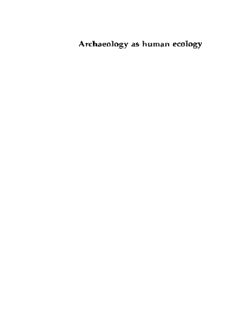
Archaeology as Human Ecology: Method and Theory for a Contextual Approach PDF
Preview Archaeology as Human Ecology: Method and Theory for a Contextual Approach
Archaeology as human ecology Archaeology as human ecology: Method and theory for a contextual approach KARL W. BUTZER Henry Schultz Professor of Environmental Archeology The University of Chicago Cambridge University Press Cambridge London New York New Rochelle Melbourne Sydney CAMBRIDGE UNIVERSITY PRESS Cambridge, New York, Melbourne, Madrid, Cape Town, Singapore, Sao Paulo Cambridge University Press The Edinburgh Building, Cambridge CB2 2RU, UK Published in the United States of America by Cambridge University Press, New York www.cambridge.org Information on this title: www.cambridge.org/9780521246521 © Cambridge University Press 1982 This publication is in copyright. Subject to statutory exception and to the provisions of relevant collective licensing agreements, no reproduction of any part may take place without the written permission of Cambridge University Press. First published 1982 Re-issued in this digitally printed version 2006 A catalogue record for this publication is available from the British Library Library of Congress Cataloguing in Publication data Butzer, Karl W. Archaeology of human ecology. Includes index. 1. Environmental archaeology. 2. Human ecology. 3. Landscape assessment. I. Title. CC81.B87 930.1 81-21576 AACR2 ISBN-13 978-0-521-28877-4 paperback ISBN-10 0-521-28877-0 paperback For ELISABETH Beethoven Op. 138 ("Leonore") Contents Preface page xi PART I Perspectives 1 Context in archaeology 3 Introduction Context and ecology Scales and dimensions of contextual archaeology Archaeology as archaeology 2 Environmental systems: spatial and temporal variability 14 Space and scale in ecology Biomes as environmental systems Equilibrium properties Scales of environmental variability Models for ecosystemic change Unique character of human ecosystems PART II Foundations 3 Geo-archaeology I: basic principles 35 Objectives Study components Techniques and procedures Ultimate collaborative goals 4 Geo-archaeology II: landscape context 43 Sedimentary matrix Point depositional environments Linear depositional environments Areal depositional environments vii viii Contents Geo-archaeological synthesis of microenvironments Topographic matrix Terrain, soils, and biota Regional matrix Environmental shifts 5 Geo-archaeology III: stratigraphic context 67 Stratigraphic nomenclature Lithostratigraphy: site and setting External correlations 6 Geo-archaeology IV: site formation 77 Archaeological sediments A Pleistocene prototype: cave sediments An example of cave geo-archaeology: Cueva Morin A Holocene prototype: village mounds Examples of urban geo-archaeology: Giza and Axum 7 Geo-archaeology V: site modification and destruction 98 Cultural transformation of archaeological residues Preburial dispersal Postdepositional disturbance Geobiochemical modification Site destruction and artifact dispersal Environmental modification of archaeological residues 8 Geo-archaeology VI: human impact on the landscape 123 Human activity and the soil-sediment system Geo-archaeological indicators of soil erosion Soil erosion in the geo-archaeological record A case study of accelerated soil erosion: Axum, Ethiopia Land use and soil fertility Geo-archaeological landscape features Landscape productivity and degradation 9 Archaeometry: prospecting, provenance, dating 157 Scope and purpose of archaeometry Subsoil prospecting Materials identification, provenance, and technology Chronometric dating 10 Archaeobotany: vegetation and plant utilization 171 The archaeobotanical record Contents ix Retrieval of archaeobotanical information Paleobotanical interpretation Dendroecology and dendroclimatology Human utilization of plants 11 Zoo-archaeology: faunas and animal procurement 191 Issues in archaeozoology Taphonomy Ecological evaluation of fossil assemblages Hunters and their prey Domestication and faunal change PART III Synthesis 12 Spatial integration I: quantitative models for pattern analysis 211 Components, subsystems, and human ecosystems Spatial archaeology Gravity models von Thunen's model Central-place theory Resource-concentration models 13 Spatial integration II: socioecological models for settle- ment analysis 230 Scale settlement analysis Large-scale mobility models for hunter-gatherers Subsistence-settlement generalizations for hunter- gatherers Spatial determinants for agricultural settlement Real versus perceived environments 14 Spatial integration III: reconstruction of settlement systems 258 Site location Archaeological site survey A landscape approach to settlement survey Reconstruction of settlement patterns: hunter- gatherers Reconstruction of settlement patterns: agricultural communities 15 Diachronic systems I: cultural adaptation 279 x Contents Temporal integration Cultural adaptation Dynamic modes of adaptive systems 16 Diachronic systems II: continuity and change 295 Adaptive transformation in the Pleistocene record: hominization Holocene adaptive transformations: taming the environment Modifications of regional adaptive systems: historical periodicities Overview and prospect References 321 Index 359
Description: